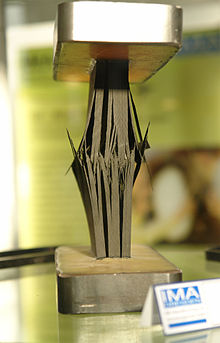
Delamination is a mode of failure where a material fractures into layers. A variety of materials, including laminate composites[1] and concrete, can fail by delamination. Processing can create layers in materials, such as steel formed by rolling[2][3] and plastics and metals from 3D printing[4][5] which can fail from layer separation. Also, surface coatings, such as paints and films, can delaminate from the coated substrate.
In laminated composites, the adhesion between layers often fails first, causing the layers to separate.[6] For example, in fiber-reinforced plastics, sheets of high strength reinforcement (e.g., carbon fiber, fiberglass) are bound together by a much weaker polymer matrix (e.g., epoxy). In particular, loads applied perpendicular to the high strength layers, and shear loads can cause the polymer matrix to fracture or the fiber reinforcement to debond from the polymer.
Delamination also occurs in reinforced concrete when metal reinforcements near the surface corrode.[7] The oxidized metal has a larger volume causing stresses when confined by the concrete. When the stresses exceed the strength of the concrete, cracks can form and spread to join with neighboring cracks caused by corroded rebar creating a fracture plane that runs parallel to the surface. Once the fracture plane has developed, the concrete at the surface can separate from the substrate.
Processing can create layers in materials which can fail by delamination. In concrete, surfaces can flake off from improper finishing. If the surface is finished and densified by troweling while the underlying concrete is bleeding water and air, the dense top layer may separate from the water and air pushing upwards.[8] In steels, rolling can create a microstructure when the microscopic grains are oriented in flat sheets which can fracture into layers.[2] Also, certain 3D printing methods (e.g., Fused Deposition) builds parts in layers that can delaminate during printing or use. When printing thermoplastics with fused deposition, cooling a hot layer of plastic applied to a cold substrate layer can cause bending due to differential thermal contraction and layer separation.[4]
- ^ Cantwell, W.J.; Morton, J. (1991). "The impact resistance of composite materials — a review". Composites. 22 (5): 347–362. doi:10.1016/0010-4361(91)90549-V.
- ^ a b Bramfitt, B. L.; Marder, A. R. (1977). "A study of the delamination behavior of a very low-carbon steel". Metallurgical Transactions A. 8 (8): 1263–1273. Bibcode:1977MTA.....8.1263B. doi:10.1007/bf02643841. ISSN 0360-2133. S2CID 136949441.
- ^ Dogan, Mizam (2011). "Delamination failure of steel single angle sections". Engineering Failure Analysis. 18 (7): 1800–1807. doi:10.1016/j.engfailanal.2011.04.009.
- ^ a b "Layer Separation and Splitting". Prusa3D - 3D Printers from Josef Průša. 2019-01-04. Retrieved 2019-05-03.
- ^ Barile, Claudia; Casavola, Caterina; Cazzato, Alberto (2018-09-18). "Acoustic Emissions in 3D Printed Parts under Mode I Delamination Test". Materials. 11 (9): 1760. Bibcode:2018Mate...11.1760B. doi:10.3390/ma11091760. ISSN 1996-1944. PMC 6165299. PMID 30231488.
- ^ Wisnom, M. R. (2012-04-28). "The role of delamination in failure of fibre-reinforced composites". Philosophical Transactions of the Royal Society A: Mathematical, Physical and Engineering Sciences. 370 (1965): 1850–1870. Bibcode:2012RSPTA.370.1850W. doi:10.1098/rsta.2011.0441. ISSN 1364-503X. PMID 22431760.
- ^ Li, C. Q.; Zheng, J. J.; Lawanwisut, W.; Melchers, R. E. (2007). "Concrete Delamination Caused by Steel Reinforcement Corrosion". Journal of Materials in Civil Engineering. 19 (7): 591–600. doi:10.1061/(ASCE)0899-1561(2007)19:7(591). ISSN 0899-1561.
- ^ "CIP 20 - Delamination of Troweled Concrete Surfaces" (PDF). NRMCA National Ready Mix Concrete Association. May 4, 2019. Archived from the original (PDF) on July 28, 2019. Retrieved May 15, 2019.